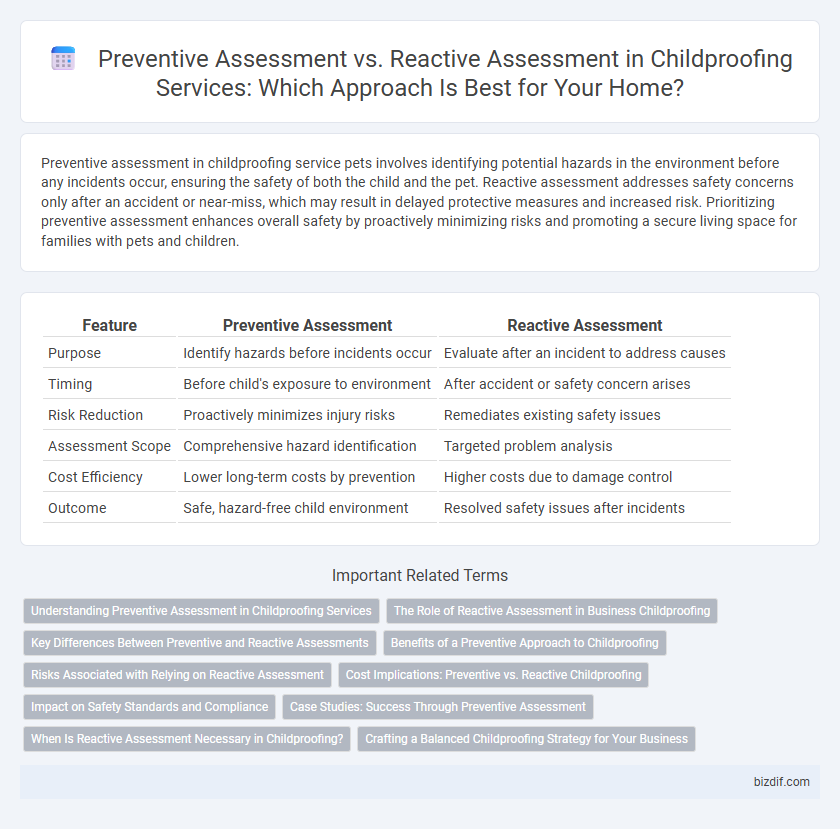Preventive assessment in childproofing service pets involves identifying potential hazards in the environment before any incidents occur, ensuring the safety of both the child and the pet. Reactive assessment addresses safety concerns only after an accident or near-miss, which may result in delayed protective measures and increased risk. Prioritizing preventive assessment enhances overall safety by proactively minimizing risks and promoting a secure living space for families with pets and children.
Table of Comparison
| Feature | Preventive Assessment | Reactive Assessment |
|---|---|---|
| Purpose | Identify hazards before incidents occur | Evaluate after an incident to address causes |
| Timing | Before child's exposure to environment | After accident or safety concern arises |
| Risk Reduction | Proactively minimizes injury risks | Remediates existing safety issues |
| Assessment Scope | Comprehensive hazard identification | Targeted problem analysis |
| Cost Efficiency | Lower long-term costs by prevention | Higher costs due to damage control |
| Outcome | Safe, hazard-free child environment | Resolved safety issues after incidents |
Understanding Preventive Assessment in Childproofing Services
Preventive assessment in childproofing services involves a thorough evaluation of a home to identify potential hazards before accidents occur, focusing on areas such as sharp edges, electrical outlets, and toxic substances. This proactive approach prioritizes safety by implementing targeted modifications to reduce the risk of injury, enhancing overall child safety in the environment. Understanding preventive assessment helps caregivers avoid costly emergency interventions associated with reactive assessments that respond only after incidents happen.
The Role of Reactive Assessment in Business Childproofing
Reactive assessment in business childproofing plays a critical role by addressing immediate safety concerns after incidents or near-misses occur, enabling targeted improvements to prevent recurrence. This approach allows childproofing providers to analyze real-world vulnerabilities through incident reports and client feedback, refining safety measures based on observed risks. Implementing reactive assessments ensures continuous enhancement of childproofing strategies, complementing preventive assessments by closing safety gaps revealed in dynamic business environments.
Key Differences Between Preventive and Reactive Assessments
Preventive assessment in childproofing involves identifying potential hazards before accidents occur, focusing on risk anticipation and elimination within the home environment. Reactive assessment addresses safety issues only after an incident or near-miss, emphasizing damage control and corrective measures. Key differences include timing, with preventive assessments conducted proactively, and scope, with reactive assessments limited to resolving identified problems rather than preventing new ones.
Benefits of a Preventive Approach to Childproofing
A preventive assessment in childproofing identifies potential hazards before accidents occur, significantly reducing the risk of injury in the home. This proactive approach allows for tailored safety solutions, ensuring that vulnerable areas such as sharp corners, electrical outlets, and stairways are secured in advance. Investing in preventive childproofing increases peace of mind for parents and caregivers by creating a safer environment for children to explore and learn.
Risks Associated with Relying on Reactive Assessment
Relying on reactive assessment exposes children to heightened hazards due to delayed identification of potential dangers, increasing the likelihood of accidents and injuries. Preventive assessment systematically detects and mitigates risks beforehand, ensuring a safer environment tailored to a child's developmental stages. Proactive strategies reduce emergency interventions and enhance overall household safety by addressing vulnerabilities before incidents occur.
Cost Implications: Preventive vs. Reactive Childproofing
Preventive childproofing assessments identify hazards before accidents occur, significantly reducing long-term medical, legal, and property damage costs. Reactive assessments address safety issues only after incidents, often resulting in higher expenses due to emergency treatments, repairs, and potential liability claims. Investing in preventive childproofing minimizes financial risks and promotes safer environments for children.
Impact on Safety Standards and Compliance
Preventive assessments in childproofing identify potential hazards before incidents occur, significantly enhancing adherence to safety standards and regulatory compliance. Reactive assessments address issues only after an incident or safety breach, often resulting in delayed compliance and increased risks. Emphasizing preventive measures ensures proactive risk management and aligns facilities with evolving child safety regulations more effectively.
Case Studies: Success Through Preventive Assessment
Case studies reveal that preventive assessments in childproofing significantly reduce household accidents by identifying hazards before incidents occur. Homes that underwent thorough preventive evaluations experienced a 40% decrease in injury rates compared to those relying on reactive assessments post-accident. This proactive approach enhances child safety by addressing risks early, demonstrating superior effectiveness over reactive measures.
When Is Reactive Assessment Necessary in Childproofing?
Reactive assessment in childproofing becomes necessary after an incident or near-miss, identifying hazards that were previously overlooked or have emerged due to changes in the environment. This assessment focuses on addressing specific risks that have already caused concern to ensure immediate safety improvements. It complements preventive assessment by providing targeted solutions based on actual events rather than solely relying on anticipated dangers.
Crafting a Balanced Childproofing Strategy for Your Business
Crafting a balanced childproofing strategy for your business involves integrating preventive assessment and reactive assessment methods to minimize safety hazards. Preventive assessment proactively identifies potential risks in environments such as daycare centers or play areas, reducing the likelihood of accidents before they occur. Reactive assessment addresses incidents after they happen, providing critical insights to refine safety protocols and ensure continuous improvement in childproofing measures.
Preventive assessment vs Reactive assessment Infographic

 bizdif.com
bizdif.com